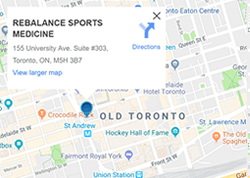Running: Bringing it back to the Basics with your ABC’s
 The ABC’s of running is a drill that was first created for sprinters but can be applied to runners. The purpose of this type of drill is to strengthen important muscles as well as help in the development of proper running form. Body awareness and mechanics are the first line of defense against injury. It is true that practice makes perfect and this exercise can help train your brain to run properly. It does this by training the correct muscles in the correct sequence to fire to ensure that we protect our bodies and run efficiently. Applying this to your running routine is a great way to build your confidence and improve your running performance.
The ABC’s of running is a drill that was first created for sprinters but can be applied to runners. The purpose of this type of drill is to strengthen important muscles as well as help in the development of proper running form. Body awareness and mechanics are the first line of defense against injury. It is true that practice makes perfect and this exercise can help train your brain to run properly. It does this by training the correct muscles in the correct sequence to fire to ensure that we protect our bodies and run efficiently. Applying this to your running routine is a great way to build your confidence and improve your running performance.
The Drill
Each movement is performed with control and focus in a walk, run or skip like motion. Start slow and then build your speed and power.
Keywords used below:
- Core – “drawing your belly button to your spine from deep within”
- Quadriceps- “quads” muscles of the front of the thigh responsible for bending the hip and straightening the knee
- Hamstrings- muscles of the back of the thigh responsible for bending the knee and extending the hip
- Tibialis Anterior- muscle on the front of the shin that flexes the ankle
“A” The driving stage
Movement is propelled by the hip flexors and quadriceps. The knee is brought up to about waist height (high knees) at a 90 degree angle from the hip and knee. During this motion the pelvis will rotate. Be sure to engage your core by drawing your belly button in towards your spine and by raising your pelvic floor. The arms are used to counter balance the action of your legs so that the arm opposite the leg is brought forward and the other one is placed behind the body with a bent elbow. Arms will swing forward and back like a pendulum. The focus should be on driving down the swing leg to the ground which initiates knee lift of the other leg. The quadriceps and the hamstrings drive this movement.
Focus on:
- Core engagement
- Step forward
- Draw leg up 90 degree bend at hip and knee
- Strong stance leg
- Arm swing opposite each other
- Driving the leg down with control of the quadriceps and hamstrings
“B” The foot impact stage
During the phase of the drill it is important to keep your foot in a controlled neutral position. This will be achieved by the contraction of the tibialis anterior. You want to land the foot below your body in this neutral position. It is important so the impact forces are spread out across the foot and it can control the
movement and absorb forces. This is important that there is less impact solely through the heel
Focus on:
- Absorbing the forces
- Neutral landing across the bottom of the foot
- The foot impacting the ground under the body
“C” The hamstring phase
In this stage the Hamstrings are dominant and powerful. They will drive the leg down and on impact continue to contract to pull the foot up under your buttocks. By practicing this part of the movement you can shorten the length of time so another stride can commence and your running speed will improve. To increase this stage, the exercise is performed more rapidly and in a burst of power action. The arms are swinging quickly and higher, mimicking the faster movement of the legs. There is also an aspect of leaning your body forward as though you are going to fall. This is similar to the forward position in which a sprinter runs as it helps to facilitate the forward momentum.
Focus on:
- core engagement
- power/speed
- hamstring contraction as you pull your foot upwards
- leaning your torso forwards
More about the Drills: When and How often?
Practice the drill a few times a week. You can incorporate it into your running warm up or set aside time at home or in the gym to train. I recommend practicing the sequencing (ABCs) for 5-10 minutes. Try going through each stage of the drill separately and then combining them into one drill. Make sure you are mindful of what your body is feeling and the muscles that are being used. This is a great way to warm up the mind and muscles for your run!
The following video provides an overview of the ABCDs of Running.
For more information and/or to work with one of our skilled physiotherapists who will help you improve your running performance and prevent running injuries contact us today.
Heather Imrie, FCAMPT Physiotherapist
Heather Imrie is a FCAMPT physiotherapist practicing at Rebalance Sports Medicine in downtown Toronto.



 What to Expect From Your First Physiotherapy Visit
What to Expect From Your First Physiotherapy Visit The Benefits of Fascial Stretch Therapy [Demo]
The Benefits of Fascial Stretch Therapy [Demo] How Does Physiotherapy Work?
How Does Physiotherapy Work? Best Exercises for Low Back Pain
Best Exercises for Low Back Pain